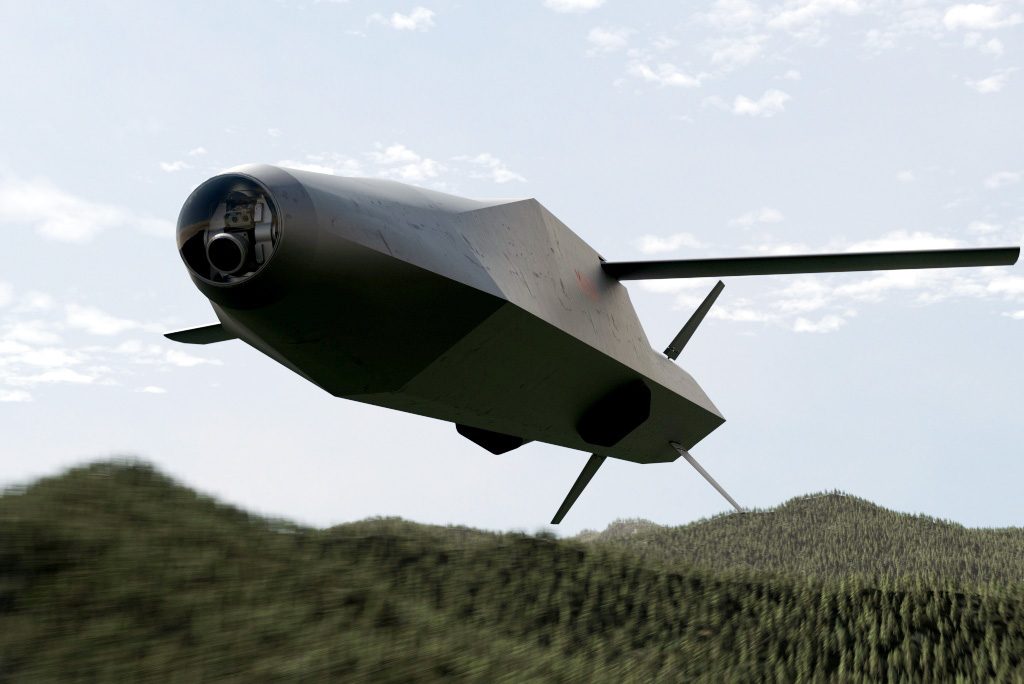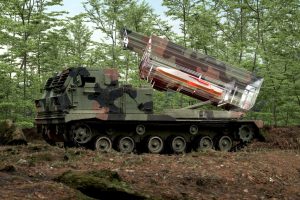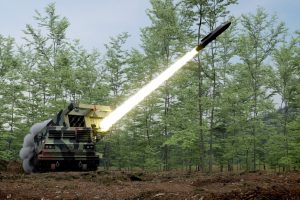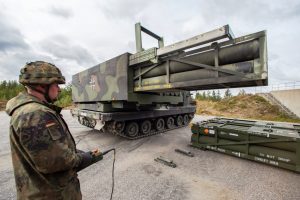
The Joint Fire Support Missile: an MLRS-launched cruise missile by MBDA
Overcoming opponent’s A2/AD threat is the key issue for western armies. Aimed at denying freedom of movement to air assets in their safety bubble, A2/AD must be overcome by unmanned means, among which surface-to-surface missiles and long range artillery are one of the answers.
To cope with this issue three German companies teamed to upgrade the MLRS launcher currently in use by the German Army and provide it with a new missile that will allow reaching the limits imposed by the Intermediate-range Nuclear Forces (INF) treaty signed in 1987 by the USA and then USSR, and denounced in 2019. Current munitions available to the MLRS are the GMLRS, with an 84 km range, the GMLRS ER (Extended Range) with a 120-150 km range, and the ATACMS (Army Tactical Missile System), with a 300 km range.
While on the other side of the Ocean Lockheed Martin is working on the Precision Strike Missile (PrSM), which should achieve Initial Operational Capability in 2023, the German industry is developing what is defined Joint Fire Support Missile (JFS-M). According to available information both solutions will allow fitting two missiles in one MLRS pod, which means that an M270 tracked launcher will be able to fire up to four missiles, while a HIMARS launcher will have two ready munitions. However similarities should end here; where the PrSM is a ballistic missile, the JFS-M is a ground-launched cruise missile (GLCM). The two solutions have pros and cons, the ballistic one might being harder to engage as it flies at higher speed, the aerodynamic-lift missile being much more flexible in terms of route to the target as well as in payloads, precision and missions.
Currently the all-German team is composed of MBDA Deutschland, Krauss-Maffei Wegmann (KMW) and ESG Elektroniksystem- und Logistik-GmbH (ESG), but other partners may join the group. MBDA is developing the effector, working closely with KMW for platform integration and with ESG to integrate mission-planning tools into the ADLER III (Artillerie-, Daten-, Lage- und Einsatz-Rechnerverbund, that is artillery, data, situation and deployment computer network), the third iteration of the German Army artillery C4I system.
“To reduce cost and time-to-market we are exploiting developments already finalised within the MBDA group as well as some sub-systems already integrated into MBDA missiles,” Björn Goller, Project Manager Sales and Marketing Land Systems MBDA Deutschland, tells EDR On-Line. While
The aerodynamic solution resembles that proposed for the SmartGlider family, which was unveiled at the Paris Air Show 2017. The JFS-M body is about 2,600 mm long and has a diameter of approximately 290 mm; in fact speaking of diameter is incorrect, as its section is far from being circular, the shape being dictated by stealth considerations. Two rear folding wings are fitted on top of the fuselage, wingspan is around 1.5 meters, while a cruciform empennage is located at the rear, the fins angled 45° from the vertical and horizontal planes; the rudder system is derived from that of the Marte missile. At launch the JFS-M is accelerated by a booster that brings it to the minimum sustainement speed, and then falls leaving the propulsion responsibility to the turbojet engine located at the rear, with the fuel tank ahead of it, close to the centre of gravity. The turbojet engine will be provided by an Eastern European company, which was not identified, while for the booster MBDA is still looking at existing solutions, by its usual provider Bayern-Chemie, a subsidiary of MBDA, or other third parties, in order to avoid the development of an ad-hoc booster.
The JFS-M take-off-weight is between 250-300 kg, its speed varying between Mach 0.5 and Mach 0.9 (600 to 1,000 km/h), which means that the missile at maximum speed would take roughly half an hour to reach a target at the maximum range of 499 km, the limit of the aforementioned INF treaty being 500 km. The airframe design is nearly frozen, according to Mr. Goller; “we developed and designed it,” he adds, “but manufacturing doesn’t fall within MBDA’s competencies, therefore a subcontractor will be selected for production.”
The navigation suite is located at the front; of course it includes a GNSS receiver as well as an inertial platform; these will be complemented by an Image Based Navigation system that will ensure maximum accuracy and will add the capability of monitoring a wide area while closing to the target, compensating any possible target movement. While older cruise missiles were using TERCOM (terrain comparison) systems, the availability of near-real time high definition satellite imagery coupled to the quantum leap in computing power made by on-board computers allows today to compare images at high speed. A 3D mission planning will be part of the system, which might also exploit waypoints to avoid as much as possible air spaces that fall under the enemy A2/AD umbrella. Designed to fly at low level, this together with its inherent stealth characteristics should ensure good survival properties to the JFS-M.
Coming to lethality, the new MBDA Deutschland project looks at modularity and scalable solutions to best fit any possible mission. The payload is located at the front, just behind the navigation suite, the latter also including the seekers used in the final phase of the attack, MBDA portfolio including electro-optic, radiofrequency and infrared sensors. Beside those, the aforementioned imaging system provides images to the computer unit where Artificial Intelligence-based algorithms ensure automatic target recognition, passive radiofrequency target reconnaissance being also available as option through an ESM suite. The new MLRS missile maintains the man-in-the-loop capability, something mandatory in the western world, a non-line of sight two-way data-link being therefore fitted both for mission update or abort.
The warhead provider is TDW, an MBDA Deutschland subsidiary co-located with MBDA Deutschland in the forest of Haguenau, in the vicinity of Schrobenhausen, 30 km north of Munich. “It will feature a high explosive multi-effect warhead capable to destroy standard infrastructures, not heavily armoured bunkers, and medium to heavy armour, as we do not consider this weapon being specifically aimed at main battle tanks,” Björn Goller explains. No indication on the warhead mass were provided, one third of the launch mass being the average for this type of weapon. The JFS-M payload bay is designed to accept multiple solutions, a trade-off between lethality and reconnaissance capability being envisaged. Packing a smaller warhead together with an electronic warfare package or a reconnaissance package is thus feasible, giving increased flexibility to the system. Beside the high lethality version reconnaissance, electronic warfare and training missiles are being considered. The JFS-M capability to fly different routes to reach the target allows obtaining a Multiple Missile Simultaneous Impact (MMSI), the missile equivalent of tube artillery MRSI (Multiple Round Simultaneous Impact). However in the case of a missile, the simultaneous attack capability is further enhanced by the fact that missiles can come from different angles, saturating local air defences. Not only, the imaging navigation system and the automatic target identification system allow the JFS-M to overfly the area of interest picking up the intended target which location was available with low accuracy, or pick-up targets of interest.
As an example a mission against a major air defence enemy asset located 300 km from the launcher can be conducted using two JFS-M, which follow completely different routes, for an overall flight distance of 320 km, that allow them avoiding enemy restricted operating zones and air defence kill boxes, reaching the time fro opposite directions at the same time, flying for 31 minutes at Mach 0.5 speed, mission planning being based on time-on-target.
A standard MLRS rocket pod can host two JFS-M; “We considered initially to install three of them into a single pod, but following discussions with KMW, which is leading the launch platform effort, we agreed on two missiles, which gives four of them for an M270A1 launcher,” Mr. Goller says. Keeping the MLRS rocket pod, which can host six standard rockets, two PrSM or one ATACMS, was considered a key design feature, as this will allow using the MBDA missile on all MLRS and HIMARS launchers, the latter wheeled platform being capable to carry a single pod. At ILA 2022 in Berlin the JFS-M was shown in a mock-up configuration installed on a wheeled platform developed by KMW. The German Army should keep its M270 launchers until 2035, and since 2030 new platforms should enter service, which will use the same pod, and some of those might well be wheeled.
Which is the current status of the JFS-M? “Currently we consider the system as a whole at TRL 4-5 [1], however a number of subsystems and elements are at a much higher TRL as we took them from existing products,” Björn Goller tells EDR On-Line. The engine and the GPS navigation are at TRL 8, while active and passive seekers as well as sensor-based navigation are based on TRL 8 [2] components. “What we still have to fully develop is the ‘brain’ of the JFS-M,” he says, adding that the other work that has to be carried out is integrating all components into the missile, something that MBDA is well used to do. “Should the customer sign a contract, the JFS-M would be available in 3-5 years time,” the PM Sales and Marketing Land Systems MBDA Deutschland states.
The version currently under development is land-based, and is aimed at the MLRS M270 and HIMARS launchers. Looking at NATO and leaving apart the United States, beside Germany these systems are in use in Finland, France, Greece, Italy, Romania, Turkey and the United Kingdom, to which we must add a number of non-NATO countries in the Middle East and Far East, therefore MBDA would have a considerable potential export market. How much the JFS-M would be competing with the PrSM remains to be seen. On one hand the latter can benefit from the FMS scheme, however the missile of German origin is fully ITAR-free; on the operational side, the two systems are completely different, and although having in service munitions of too many types is always a problem from the logistic standpoint, having both systems at hand would allow artillery to select the best effector depending on the tactical situation.
As said the current version of the JFS-M falls in the GLCM category; in that version it can be installed on existing platforms as well as on future platforms that will retain the same pod used on the MLRS, a stand-alone version being also conceivable. However MBDA is already considering versions of the missile to be launched from naval platforms as well as from airborne platforms, in the latter case the missile lacking the launch container and the booster. The focus on artillery is clear, considering what is happening in Ukraine, therefore some good news for the German branch of the European missile company might come soon.
Images courtesy Bundeswehr and MBDA
[1] TRL 4. technology validated in laboratory; TRL 5. technology validated in relevant environment
[2] TRL 8. system complete and qualified






